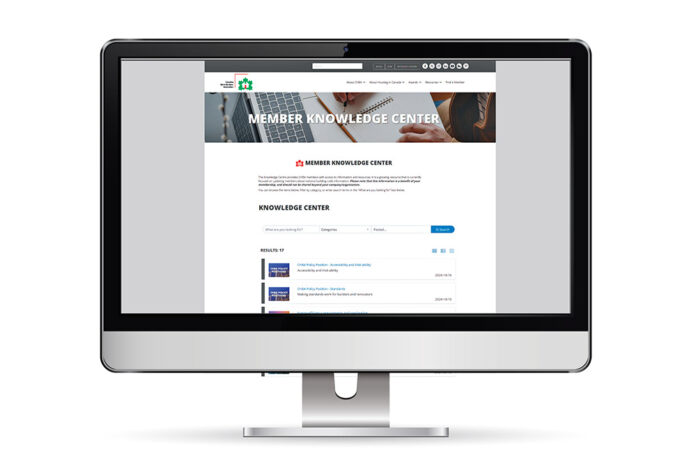Frank Lohmann, Senior Director, Building Science
If it feels like significant building and energy code changes are coming at a fast pace, that’s because they are. The residential construction industry is being inundated with late adoption of 2020 codes and major proposed changes to Canada’s 2025 National Model Construction Codes at the same time. Each proposed change has implications on how homes are built and renovated, and should ideally be evaluated based on its feasibility and impact on affordability. Keeping up with the sheer volume of proposed changes is an extremely difficult task, and it doesn’t look like it will slow down any time soon. The association works with members to provide input into the code system to bring the industry’s perspectives, concerns and recommendations to the code development process, and to stay on top of the implementation challenges and upcoming changes to best prepare members for the future. Below are some highlights to show the work being done.
Knowledge Centre
CHBA’s newly launched Knowledge Centre will help share technical information with members more efficiently. This searchable repository includes building code meeting briefs and summaries of public consultations so that all members can stay informed about new and proposed building code changes and technical information.
Find it under at chba.ca under Resources > For Members > Knowledge Centre.
58 and 162
Technical Research Committee Members and TRC Meeting Attendees
CHBA’s Technical Research Committee (TRC) is comprised of the provincial HBA representatives (which make up the TRC Management Committee) and members representing more than 30 organizations including government research agencies, codes and standards organizations, allied industry associations, colleges, university research networks, home warranty providers and other members at large. Showing the importance of these meetings and the interest members and HBA staff have in content covered at TRC, the last TRC meeting in Ottawa had more than 160 attendees, including observers.
TRC is the CHBA’s forum for all things related to innovation, new technologies, building and energy codes, standards and regulations affecting how homes are constructed. TRC also works to identify technical problems being experienced by the industry, to achieve consensus on their priority, to mobilize private and public R&D resources to resolve these problems and to communicate solutions to members. TRC’s Management Committee occasionally provides policy advice to CHBA’s Board of Directors.
1085
Hours, Code Meetings
Keeping up with all the code changes takes a lot of staff time. So far in 2024, CHBA National staff have spent a combined total of 1085 hours participating in code meetings, reading thousands of pages of code change proposals ahead of meetings, and interpreting the impact these changes will have. This number does not include the invaluable time also spent by members in these meetings, or the staff time collecting and summarizing member feedback to inform the committees and influence the proposals, or for time spent communicating the resulting codes-related information to members and HBA staff across the country.
457
Innovative and Standardized Products
If you have ever found yourself wanting to use a very innovative product that is not in the code and for which no standard exists, you will likely know about the Canadian Construction Material Centre (CCMC). The CCMC issues evaluation reports of innovative building materials and produces listings of standardized products available on the CCMC’s registry. In addition, 277 brand new products are being actively evaluated now. CHBA staff participates as a member of the Canadian Commission of Construction Material Evaluation and makes sure that CCMC continues to improve its service and delivery speed for innovative products being evaluated and brought to market.
186 of 1,200
Updated Referenced Standards
One-hundred and eighty-six of the 1,200 standard references in the national codes are being updated for 2025. Every two to three years, codes are trying to catch up and update all references to the respective newest standards’ edition. Unfortunately, standards committees are not required to conduct cost-benefit analysis. This means that each code’s update of these standard editions adds unknown cost to the construction of homes. CHBA continues to flag this as an issue and to monitor the fast-paced updating to ensure there is no conflict with other parts of codes and that high-cost items are flagged. Many of these standards are still available to the public only at a considerable cost, and CHBA is calling for all codes and standards referenced in the NBC to be available for free.
26
Maximum July Outdoor Temperature Requiring Cooling
One Proposed Change Form (PCF) 2061 coming soon to a special public review suggests mandatory mechanical cooling for homes located in regions with maximum July Design Temperature of 26 Celsius or more. CHBA is participating at all levels of code meetings to make sure this fast-paced change, driven by high political priority after the BC heat dome in 2021, can be implemented without difficulty and the costs of this change are being made transparent.
6
Public Review Periods (in 2023-24)
These two-month public review periods on proposed changes to national construction codes allow CHBA with the guidance of members to submit comments on future code proposal. These comments – whether supportive or not – can have profound impacts on how affordable homes will be in the future and CHBA continues to rely heavily on input from members during each public review.
13
All-New Code Committees
All national codes committee structures for the national model code development are changing in January 2025. The current Standing Committees will be dissolved, and new National Model Code Committees will be created. This means there will no longer be a single committee dedicated to Part 9 of the code. CHBA is a working on participating in all committees, but predicts it will be immensely challenging to bring industry input to this new structure.
374
Proposed Code Changes
Codes Canada’s database of code change requests and proposed changes indicates that there are 374 proposals approved for the four National Model Construction Codes for 2025. CHBA members and staff are involved in the national model codes development, either as committee members or observers.
1•2•3•4•5
Energy Efficiency Performance Tiers in National Codes
The 2020 National Codes have introduced five tiers of progressively ambitious energy efficiency. They are called “Tiers” and go from 1 to 5. According to agreements signed by the provinces, by March 2025 all provinces are to have adopted the national codes and one of these tiers will be the mandatory minimum. So, one number will decide how efficient new homes in your province will be. Tiers 1 and 2 are prescriptive while tier 3, 4 and 5 in the 2020 codes are only available through modeling. The proposals for the 2025 national codes (expected to be adopted in 2027) will offer more prescriptive guidance and a points trade-off method for tiers 3, 4 and 5.
3,042
Webinar Participants
CHBA has hosted seven webinars over the last eight months with more than 3,000 registrations. The webinars inform members about proposed code changes and about the comments that CHBA would likely submit during the respective public reviews. The webinars are still available for members who want to review them to find out what the next building and energy codes may bring. Members can access them at chba.ca/webinars.











